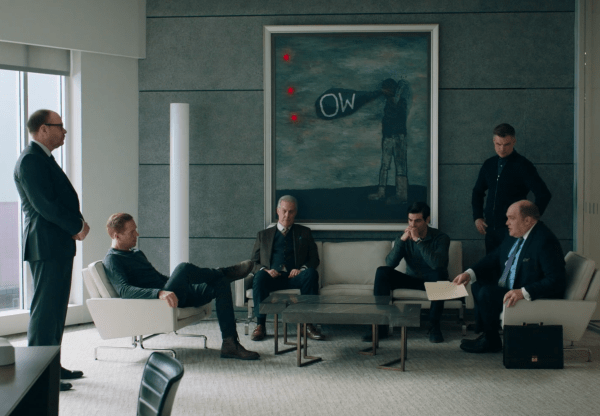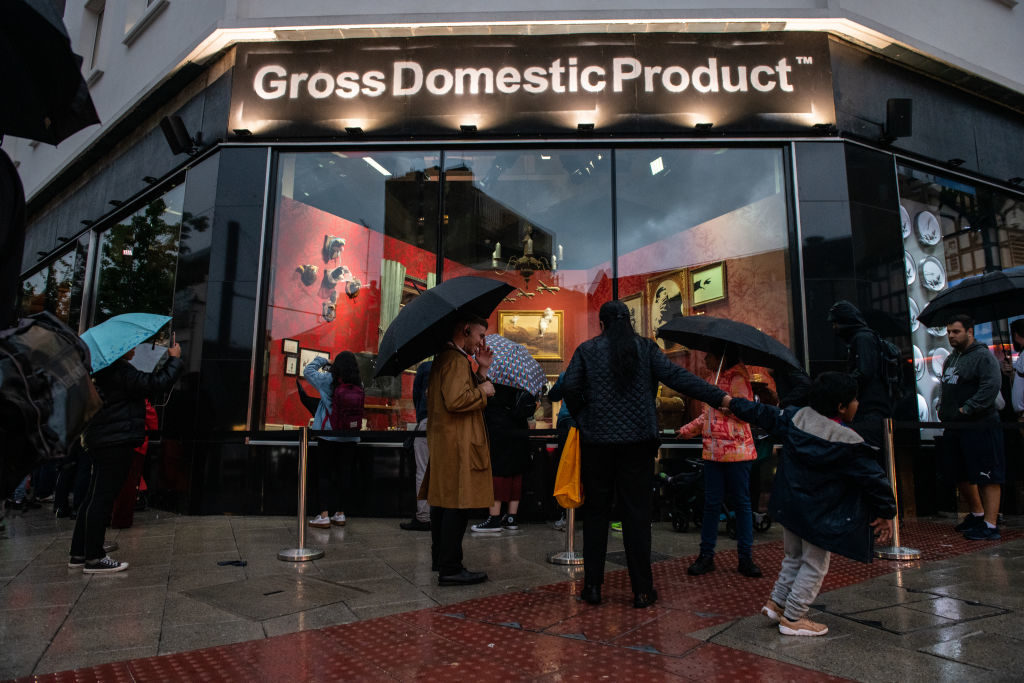Law & Politics
What Rights Does a Model Have Over Her Own Image? + Other Artists’-Rights Questions, Answered
Who do home makeover shows always blur out the art on the walls? Why isn't Banksy allowed to trademark his work? We're here to help.

Who do home makeover shows always blur out the art on the walls? Why isn't Banksy allowed to trademark his work? We're here to help.

Katarina Feder

Have you ever wondered what your rights are as an artist? There’s no clear-cut textbook to consult—but we’re here to help. Katarina Feder, a vice president at Artists Rights Society, is answering questions of all sorts about what kind of control artists have—and don’t have—over their work.
Do you have a query of your own? Email [email protected] and it may get answered in an upcoming article.
A question regarding that great Emily Ratajkowski article in the Cut: She describes sitting for photographer Jonathan Leder for the magazine Darius (no pay, just exposure). Afterward, he published a series of books with outtakes and images from the shoot. According to Ratajkowski, her agent never signed a model release that would have allowed the images to be used for purposes beyond the magazine. What rights does a model have to her own image?
For those who are unfamiliar with the dilemma: before Emily Ratajkowski hit the big time, she was just your everyday aspiring creative traveling to the Catskills for a photo shoot. As Ratajkowski recounts in her essay, the shoot devolved, leading to a sexual encounter with the photographer, Jonathan Leder, that may not have been consensual. In the years that followed, Leder published numerous books with photos from the shoot in a clear attempt to capitalize on Ratajkowski’s fame.
Ratajkowski leaves the details of her legal situation vague, but she hints that someone may have forged some kind of release without her knowledge. Model releases are sacrosanct in the world of photography—even photographers accused of allegedly unethical activity have been sure to take care of the paperwork beforehand.
One would-be model in Ohio saw her photo on the cover of “Horny Housewives of Dubai” in 2014, despite the photographer’s “unconditional promise” that the lingerie shots would not be used as pornography. The woman eventually had to withdraw her $500,000 suit, likely because she had signed a “universal adult-model release for all agencies.” (For his part, the photographer said he made a point of NOT telling her that her photographs would NOT be misused, a fascinating defense.)

Katherine Heigl on July 11, 2017 in Los Angeles, California. This is not the photo she sued over. (Photo by BG005/Bauer-Griffin/GC Images)
What’s at issue here are generally called “personality rights” or “publicity rights.” The general idea is that people operating with the assumption of privacy should be able to control how their image is used, especially when someone else is profiting off of it. In 2014, for example, the actor Katherine Heigl sued Duane Reade for tweeting a picture of her shopping, therefore fighting for the rights of all New Yorkers to show up at a Duane Reade looking however they damn please!
Interestingly, in today’s Insta-everything world, many lawsuits involving celebrities’ personality rights have gone in the other direction, with paparazzi suing their celebrity subjects for posting photographs taken of themselves on social media.
In addition to the likes of Gigi Hadid and Jennifer Lopez, Ratajkowski, too, has been legally pursued by paparazzi whose photographs she has posted, which is part of what makes her article so strong. These public figures appear to have no agency over the use of their own likeness.
In the case of Leder’s photographs, no forged release was necessary to protect him from a lawsuit. There are numerous exceptions to New York’s privacy laws, including a large one about newsworthiness that necessitates the need to demonstrate “actual malice” and a “severe” degree of falsity. And then there’s the fact that Leder seems to be selling this photo collection as an art book, which might also be protected. (A 1998 Tiger Woods lawsuit hinged on the question of whether or not Rick Rush’s painting The Masters of Augusta should be classified as a genuine artwork or piece of sports memorabilia. Since you no doubt studied that one in your art history class, I don’t have to tell you that the Sixth Circuit ruled it an artwork.)
Ratajkowski seems to recognize these landmines; the article is written as if the only thing she intends to gain is the ability to warn others about complicated issues surrounding consent when it comes to both art and sexuality. She does a very good job of it. If you’re reading this column and still haven’t read her piece, I’d urge you to do so.

The cast and crew of Extreme Makeover: Home Edition preparing to surprise the Fifita family in Hawthorne on Thursday, September 12, 2019. (Photo by Brittany Murray/MediaNews Group/Long Beach Press-Telegram via Getty Images)
I was recently watching the TLC home makeover show Nate & Jeremiah by Design, one of my favorite activities to do after work to dream of a better life. I happened to notice that in the “before” tour of the house, every single work of art on the walls was blurred out. Why do they do this? Does this mean that if you are an artist and you spot a work of yours on TV, you could sue? And who exactly could you sue?
To me, the better question is, why don’t they blur some of the post-makeover art?! I’ll never understand how these shows manage to convince so many otherwise intelligent people that they should hand over their house keys to television personalities equipped with little more than mood boards and a glue gun…
Anyway! You’re referring to a process known as “product displacement,” i.e. the opposite of “product placement,” or “greeking.” Greeking, a term borrowed from the phrase, “It’s all Greek to me,” was coined in English by none other than the Bard himself. In the context of home makeover shows, greeking refers to the use of placeholder content that is intentionally vague.
Brands also greek out. Although it feels slightly dated now, a good example is the use of a Mercedes Benz in the film Slumdog Millionaire. After the film premiered, Mercedes decided that they didn’t want their brand associated with the ghettos of Mumbai, and thus demanded to be taken out of the film.
This right also applies to artists. As readers of this column know, an artist retains the copyright to the image of his or her art regardless of who owns the physical work (unless they sign away the copyright). The people getting a home makeover can sign waivers to allow the use of their children’s images, but not the art hanging on their walls—they can’t give away copyrights they don’t own.

Painting by filmmaker David Lynch fill Axe Capital headquarters in season five of Billions. Courtesy of Showtime.
Every time you see a Picasso on Succession or a Basquiat on Billions, it was the result of set designers obtaining permission from the artist or estate. (By the way, the works shown, especially on scripted television, are almost always copies.) In the content boom of the past five years, we at the Artists Rights Society have seen a threefold increase in such clearance requests.
So, to answer your question as succinctly as possible: If you’re a painter who sees their work on screen and it hasn’t been cleared beforehand, something has likely gone wrong, and you may be eligible for compensation from the network.
Oi! Did you see that Banksy recently tried to trademark his bloody graffiti of a bloke tryna throw a bouquet like it were a molotov? What do you reckon he’s planning? Didn’t think you could even trademark graffiti, innit.
In brief: copyright is granted automatically to every work of art from the moment it is completed, but trademark is something you have to apply for. (More often than not, a trademark is a logo.) They help prevent rip-offs and let consumers know that the product is authentic. Put another way: they mark your trade.
Artists rely on copyright to protect their work from infringement, so already there is a sort of Banksy-style joke going on here. We have an artist behaving more like a brand. Your question seems to imply that Banksy is doing this for a bigger stunt, which would be a fair assumption. After all, he does seem to be working the institutional critique angle a bit more these days.
Publicity stunt or not, my sense is that Banksy is legitimately attempting to prevent further infringements of his work. Since 2014, Banksy has been trying to stop a greeting-card company from reproducing his graffiti on their cards, but has lost every decision. The fact that the guy insists on remaining anonymous doesn’t help: While you can copyright a work anonymously in both the US and the UK, it does tend to complicate things, which may be why Banksy has attempted to go down the trademark route.

Members of the public queue to look at the new Gross Domestic Product installation by elusive artist Banksy on October 1, 2019 in Croydon, England, which the artist has said was created to thwart greeting-card company Full Colour Black from stealing his work. (Photo by Chris J Ratcliffe/Getty Images)
Last year, the street artist created a pop-up store, “Gross Domestic Product,” to attempt to merchandise on his own, stating, “For the past few months I’ve been making stuff for the sole purpose of fulfilling trademark categories under EU law.”
This did not go over well with the EU Intellectual Property Office, which wrote:
Banksy has chosen to remain anonymous and for the most part to paint graffiti on other people’s property without their permission … He has also chosen to be very vocal regarding his disdain for intellectual property rights … It must be pointed out that another factor worthy of consideration is that he cannot be identified as the unquestionable owner of such works as his identity is hidden; it further cannot be established without question that the artist holds any copyrights to graffiti.
As a cautionary tale, I am reminded of the story of the British punk music entrepreneur Tony Wilson, who died penniless because his anarchist music contracts left him with nothing in the way of royalties. “I used to say, ‘Some people make money and some make history,’ which is very funny until you find you can’t afford to keep yourself alive,” Wilson said. Nihilism and anarchy do not put food on the table. Perhaps Banksy just wants, or needs, some bank.
I’m a working artist and my roommate is addicted to the Real Housewives shows. I’m now mulling a project that would do something with screen grabs from the series. I should say that I am not a painter, and in fact I would want to do as little as possible to manipulate the image captures. Would that be allowed?
You’re telling me Real Housewives isn’t a form of art already? Shahs of Sunset isn’t art? Vanderpump Rules?! But if you insist on trying to improve on perfection, you should be in the clear.
You know that phrase they put on screen at the end of a football game? “Any other use of this telecast or pictures, descriptions, or accounts of the game without the NFL’s consent is prohibited”? That’s bluster, and it’s inaccurate. They own the telecast, but they can hardly stop someone from photographing or describing the game, both of which clearly fall under the “criticism, comment, news reporting, teaching, scholarship, and research” copyright exceptions broadly defined as fair use.
So go ahead and use those ladies as your artistic muses. We’ll be cheering for you. Bravo!